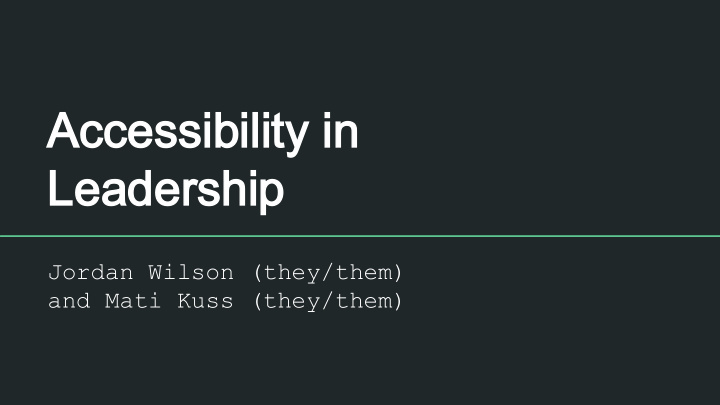



Accessibility in Accessibility in Leadership Leadership Jordan Wilson (they/them) and Mati Kuss (they/them)
Community Agreements Community Agreements ● Respect of names and pronouns -- use name, or gender neutral pronouns if pronouns are unknown ● Using gender-inclusive language when referring to the group (eg. “you all” not “you guys”) ● Self care ● “Bubbles” ● Don’t assume ability or capacity ● Provide content/trigger warnings ● Patwin land ● Take care of biological needs ● Feel free to move your body in any way you need
Learning Objectives Learning Objectives ● Be able to define what accessibility is and why it is important. ● Be able to identify different barriers to accessibility in events, as well as possible solutions to these barriers. ● Be able to plan events that strive to be as accessible as possible.
Dylan Marron: Dylan Marron: "Unboxing Ableism" "Unboxing Ableism"
Katie Tastrom: "Accessibility is Not Disability Katie Tastrom: "Accessibility is Not Disability Intro to Intro to Justice: I’m Tired of Fighting" Justice: I’m Tired of Fighting" Accessibility Accessibility ● ADA accessibility vs an Accessible space ● Who is doing the labor of accessibility? ● How does disability justice fit in? [image description: Light skinned man with hand out. Man labeled “social justice organizations”, Butterfly near man’s hand is labeled “basic accessibility measures”, caption on bottom of picture says “is this disability justice?”]
Language Language ● Use Gender-inclusive language ● Avoid Ableist Language ○ Ex. crazy, insane, dumb, stupid, r***rd, c***ple, etc. ● Understanding for different comfortability level with a given language. ○ Providing interpreters if asked ● Avoid elitist language ● Respect for different forms of communication/ways of communicating
Annie Elainey: “How to Improve Annie Elainey: “How to Improve Accessibility at Your Event Accessibility at Your Event
Planning Events Planning Events ● Outreach and Advertising ○ Font size and type ■ Minimum 12pt, Sans Serif or Slab Serif ○ Colors ■ Contrast and color-blindness ○ QR codes/links ■ Shorten and provide both when possible! ○ Screen readers ■ Provide image descriptions (including for emojis!) ○ Fee-waivers ○ Available accessibility information before the event! ○ Available contact info for more accessibility options
Planning Events Planning Events ● Presentations ○ Assisted listening ○ Captions /ASL ○ Image descriptions ○ Printed slides ○ Content/trigger warnings ○ Photosensitivity warnings
Planning Events Planning Events ● Physical Space ○ Furniture setup ○ Leaving accessible spots open ○ Accessible door buttons/heavy doors ○ Stairs, elevators, ramps ○ Parking ○ Gender-neutral restrooms ○ Food- ■ Provide it and with full labels and info ■ Alcohol ○ Scent-free spaces ○ Sensory rooms/decompression ○ No forced participation ○ Stim toys ○ Acknowledging bio-breaks ○ Service animals
● Application Application ○ Think back to an event you have put on or attended (can include the current event) ■ What did organizers do to make the event more accessible? ■ What could have been done to make it more accessible? ■ How will you incorporate what you have learned into future event planning?
Sources Sources ● Dylan Marron: "Unboxing Ableism" https://tinyurl.com/ybuu9xnq ● Katie Tastrom: "Accessibility is Not Disability Justice: I’m Tired of Fighting" https://tinyurl.com/ycrp8gnz ● Annie Elainey: “How to Improve Accessibility at Your Event” https://tinyurl.com/y7e3aw9m ● Recite Me: “Choosing an Accessible Font” https://tinyurl.com/y8676ubt ● Color Safe: “Accessible Web Color Combinations” http://colorsafe.co/
Recommend
More recommend